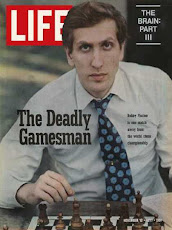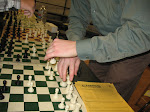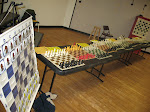THE SPECIAL MOVES OF PAWNS...
Here is a "fictional" game that I have created to showcase two of our three special moves - both of the special moves that only the pawns can do! They are:
#####################################################- PAWN PROMOTION - Get one of your pawns to the other side of the board and cause a commotion with a pawn promotion. With each pawn that promotes you can either get a QUEEN, KNIGHT, BISHOP or a ROOK back onto the board. You cannot have another King or leave the pawn as a pawn - it must promote. You must place the piece that you are promoting to on the square that your pawn touches down/lands on.
- EN PASSANT CAPTURE a.k.a. IN PASSING CAPTURE. A special move that some Adults do not even know and some experienced tournament players have forgotten about - until it was too late! This is a law of chess that allows one of your pawns that is five ranks away from you (Five squares away from your side of the board) to capture an enemy pawn that jumps up two squares to stand shoulder to shoulder with your pawn. You may only play this capture on your turn after they have played their pawn move - if you wait then you lose the right to "Capture in passing".
"The Start Position"
- As the board should be set up.
 Once again notice the Letters along the side - going up towards the Black side of the board. These are the "Ranks" and each rank goes from across the board left to right. The first Rank is where the White pieces live.
Once again notice the Letters along the side - going up towards the Black side of the board. These are the "Ranks" and each rank goes from across the board left to right. The first Rank is where the White pieces live.- Notice the letters along the bottom of the chess board - these are the individual files. The files go up and down the chess board. E.g. The b-file has the White Knight on the b1 square and goes all the way up to the top of the board to where the Black Knight starts the game on the b8-square.
- To find what square is being identified you can "cross reference" the ranks and files. Draw imaginary lines up the files and find where the ranks cross over them and you will have found the name of whatever square you are looking for. E.g. The square e3 is a green square two square in front of the White King.
- The white pieces are always set up on the first rank while the white pawns are set up on the second rank. The black pieces are set up on the 8th rank and the Black pawns are set up on the 7th rank at the start of every game of chess.
EACH OF THE PAWNS CAN MOVE 1 or 2 SQUARES
*On the first move, after that only one square please!
*On the first move, after that only one square please!

- Notice that pawn march forward - but they attack the squares diagonally in front of them.
- In the above example the move 1.e4 has been played. A pawn lands on the e4 square and now it attacks the squares f5 and d5 - where I have placed the circles.

- BLACK COPYCATS!
- This is a good move though. This pawn that jumped up to the e5 square is preventing the white pawn from moving forward.

- White has just played an "OPENING" known as the KING'S GAMBIT. Openings have names - usually after people or places. There are three parts to a game of chess: The OPENING, MIDDLE and ENDGAMES.
- The Black pawn can now grab the white pawn that has jumped onto the f4 square. We would do this in a game by picking up the f4-pawn and then putting our e5 pawn on that square.
- Set up your own chess board and copy these moves to get them down.

- The capture has been made.
- This is known at the KING'S GAMBIT ACCEPTED. You do not need to remember the names of the openings right now. Just finding good squares for our pieces will be our first priority whenever we play a game of chess - no matter what opening we are playing.
 SPECIAL MOVE #1 - HAPPENING NOW!
SPECIAL MOVE #1 - HAPPENING NOW!- The move 3. g4 is a mistake - we will find out why in a moment.
- TRUE or FALSE - Can the pawn on f4 capture that pawn that just ran by him/her?
- Remember the circles are the squares that our f4 pawn attacks.
aha

- The answer is YES it is TRUE, the black pawn on e5 can capture the "runner" that ran onto the g4-square. To understand why this is so allowed let us take a look at the board position up above.
- IF the pawn that HAD been on g2 had gone to g3 - instead of the g4-square - then the black f4-pawn would be able to capture the g3 pawn. Remember his arms? Those circles?
- Well the white pawn is in one of these circles right now. So here we can play the move for black 3. ...fxg3 - which in English means pawn takes pawn.
- ...even if the pawn runs up two squares it can still be captured by the enemy pawn. Because this white g-pawn still passed through a square with a "circle" or attack upon it.
- This special rule only applies to pawns. Pawns are unable to capture pieces "In passing" because pieces are not pawns. There is a difference!
 MOVING RIGHT ALONG...
MOVING RIGHT ALONG...*
Why was the move 3. g4 a mistake? Because it helps to weaken the squares around the White King. Once a pawn moves forward it cannot turn back - there is no going back but only forward!
*
Here are the moves to this game as played so far - don't forget to read the PDF file that I sent out in our email about "HOW TO READ AND WRITE CHESS NOTATION" - a handy file put out by the USCF (United States Chess Federation), which is the standard notation used all around the world. The only difference being that some countries will use different letters to represent the various pieces because the pieces have different names in different parts of the world.Now for a series of moves to show how badly we can weaken the area over on the King's side of the board. This will allow us all to see our next special move = PAWN PROMOTION (a.k.a QUEENING THE PAWN)!
*
- 1. e4 e5 2. f4 exf4 3. g4?? fxg4 E.P.
- The next move played weakens the light squares even more - 4. Bc4?? is a terrible move.
- Black to play and win 5 points. Can you find the move?

- OUCH! Yes - just because the pawn on g3 COULD HAVE captured the white pawn on h2 doesn't mean that it has to. He could still march forward because no one was standing on or guarding the g2 square.
- Pawns, Queens and Bishops can attack Rooks and Knights without being attacked in return by the piece that they are threatening. Rooks can only move along RANKS and FILES - a diagonal attack is something that Rooks always have to watch out for and Bishops can move along these diagonals while Queens can combine the moves of Bishops and Rooks.
- The only way to defend against a diagonal attack upon a Rook is either remove the attacker with one of our other pieces - if possible, to move out of the way - again if possible or to throw one of our other pieces in the way between the attacker and our Rook - this is called blocking.
- The move played would be written down as 4. ...g2 - again I give the complete "game score" down below, in the next bullet.
- 1. e4 e5 2. f4 exf4 3. g4?? fxg4 E.P. 4. Bc4?? g2! (Take that Mr. Rook!!)
- Notice that the Rook is trapped in the corner - his friend the Knight is in the way.

The King is too slow to win this foot race! Remember he can only move one square at a time - unless doing his special move - CASTLING (See post above)!
SPECIAL MOVE #2 - HAPPENING NOW!
SPECIAL MOVE #2 - HAPPENING NOW!
 Aha - and here it is. The other special move of pawns - PAWN PROMOTION. This pawn has just promoted - turned into - a Queen. From humble beginnings this pawn ended up becoming royalty!
Aha - and here it is. The other special move of pawns - PAWN PROMOTION. This pawn has just promoted - turned into - a Queen. From humble beginnings this pawn ended up becoming royalty!This e-pawn has been on quite a journey - first he/she/it started the game off on the e7-square, then he jumped up to the square e5. When he was attacked by the white f-pawn he captured and then got to capture the g-pawn using "EN PASSANT CAPTURE" or the "IN PASSING CAPTURE" rule - the first Special move we looked at in this posting. Having landed on the g3-square the next stop on this pawns journey was the square g2. Because the White Bishop moved away the Black pawn was able to attack the white Rook that was locked in the corner on the h1-square.
TWO MORE SPECIAL MOVES - Now you can add those moves to your bag of chess tricks!
I now give the moves to this game down below in the game score...
1. e4 e5 2. f4 exf4 3. g4?? fxg4 E.P. 4. Bc4?? g2! 5. Kf2 gxh1=Q. Black is winning by a serious amount of points in this game now.
I hope you all have enjoyed this tutorial - feel free to send any questions to me at my email address.
Your Chess Coach
Coach Sean Tobin.








No comments:
Post a Comment